
views
Structuring Your Talking Points
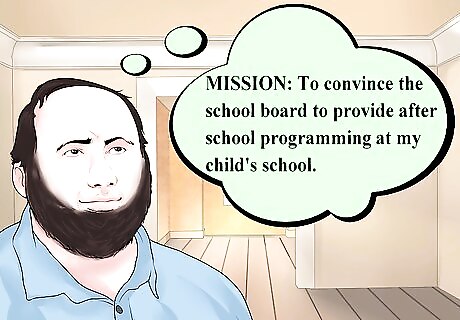
Identify your mission or message. Consider why you are speaking to your audience and identify the purpose of your speech or interview. Is your main mission to convince a committee to support your policy or a change to an existing policy? Is your main message to tell an audience of students about your experiences in a foreign country? Are you trying to present a specific issue or problem at your child’s school to the PTA board? Are you giving an interview to a local newspaper about a local issue or to promote a product? Focusing on the main purpose of your talk will then help you create the rest of your talking points. You can develop your message by thinking about emotion, or what you want your audience to feel, contrast or how your message is different than the message of others, connection, or why your audience should care about what you are saying, and credibility, or why your audience should believe what you say. For example, maybe the main message of your talk is to argue for the creation of after school programs at your child’s school. You may then identify the mission of your speech as: “The mission of my speech is to convince the school board to provide after school programming at my child’s school.” If the main message of your interview is to discuss the latest product released by your company, you may write out the mission as: “The mission of my interview is to promote the 2016 release of the lightweight hover board by my company, Hover, Inc.”

Outline two to three talking points. Once you have identified your main message, you can then create two to three main talking points to support your main message. You will then use these main points to develop supporting arguments or examples to ensure your main message is well supported. Focus on talking points that will help you prove your main message or expand further on your main message. Your talking points should be clear, short, and to the point. Think of your talking points as your elevator pitch, made up of keywords or short sentences. For example, if the main message of your talk is to argue for after school programs at your child’s school, they may be structured as follows: Benefits my child’s education, will supply her with educational activities in a controlled, monitored environment. Benefits other students at Normandy who need educational guidance and activity once school hours are over. Benefits the other parents of students at Normandy High School by providing education and guidance for their children.

Provide specific examples to support your talking points. You should use examples that are personal and impactful, with the strongest examples listed first. Your examples may be personal stories of success that illustrate the importance of your talk or data that show how useful and effective the main points of your talk will be for your audience. Though it may be tempting to make a long list of examples, try to focus on one to two examples that best illustrate your main point or mission. Most speeches are the most effective when they are short and to the point, especially if you are arguing for a particular position or stance on an issue. For example, if you are arguing for after school programs at your child’s school, you may tell a short story about how your child struggles with her math assignments and is looking for tutoring that could be provided through the after school program. You may also use data from a national study on after school programs that show how well students in after school programs do in their academics and in their community as a result of these programs. Your talking point may look like this: Talking point: Benefits your child's education, gives her support in a controlled, monitored environment. Example 1: Story about her math assignments. Example 2: National study on after school programs and academics. EXPERT TIP Lynn Kirkham Lynn Kirkham Public Speaking Coach Lynn Kirkham is a Professional Public Speaker and Founder of Yes You Can Speak, a San Francisco Bay Area-based public speaking educational business empowering thousands of professionals to take command of whatever stage they've been given - from job interviews, boardroom talks to TEDx and large conference platforms. Lynn was chosen as the official TEDx Berkeley speaker coach for the last four years and has worked with executives at Google, Facebook, Intuit, Genentech, Intel, VMware, and others. Lynn Kirkham Lynn Kirkham Public Speaking Coach Our Expert Agrees: Use examples that come from your heart, and that feel authentic. The most powerful talking points will speak to your audience and inspire, motivate, or elucidate a point.
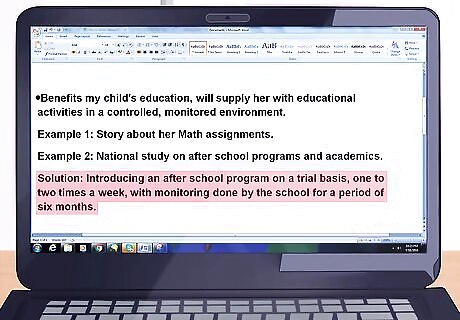
Emphasize a win-win solution. Let your audience know why they should care about your talk by providing possible solutions or ways to enact your suggestions. Your talk should not only identify a main message or problem; it should also give your audience several ways to solve or address the main message or problem. Ideally, your talk should present a solution that feels like a win for you, as the speaker, and a win for the audience, your listeners. For example, if you are creating possible options or solutions for your argument for more after school programs at your child’s school, you may give one option: introducing an after school program on a trial basis, one to two times a week, with monitoring done by the school for a period of six months. This can act as a test to see how effective the program is for the students at the school.

End with a call to action. Provide information on what the audience can do to support your mission. This could be in the form of giving a donation, signing a petition, buying a product or volunteering time for a cause. Ending with a call to action will give your audience the opportunity to respond to your talk in a proactive and tangible way. To end your talk on after school programs, you may ask your audience to consider signing a petition to support after school programs. You may also ask that the school consider your proposal and respond to you in writing by a set date. This will allow you to hold your audience accountable for any promises made as a result of your talk.
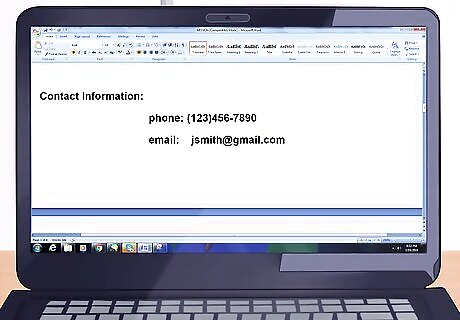
Provide contact information, if applicable. Let your audience know how they can get in touch with you or your organization. This could be a toll free phone number, an email address, or a website. If you or your organization uses social media to connect with customers, you may also provide your social media contacts. Supplying your contact information will show that you are committed to your main message or mission and are willing to speak directly to individuals in the audience. This can also allow audience members to contact you directly with any questions or concerns they may have as a result of your talk.
Formatting Your Talking Points

Use a bulleted list. Organize your talking points in a bulleted list, with your main message or mission stated at the top of the list and your main talking points placed below, with the strongest point listed first. You should also include one to two supporting arguments within your main talking points. A sample bulleted list may appear as follows: Main message/mission: The mission of my speech is to convince the school board to provide after school programming at my child’s school. Talking Point 1: Benefits my child’s education and supply her with educational activities in a controlled, monitored environment. Supporting argument: My daughter struggles with her math assignments and has a difficult time socializing with other students. She comes home from school defeated and unmotivated, and as a busy working mother, I do not have the means or the time to support her academically. An after school program could provide math tutoring and the opportunity to interact with other students in a more open, recreational environment. Talking Point 2: Benefits other students at Normandy who need educational guidance and activity after school hours are over. Supporting argument: Statistics show that students who attend after school programming score higher on standardized testing and develop stronger social skills with their peers. An after school program can help provide students with the chance to interact in a controlled and monitored environment that is positive and safe. Talking Point 3: Benefits the other parents of students at Normandy High School by providing education and guidance for their children. Supporting argument: I have spoken with other parents of Normandy students who are working late hours to provide for their families and who are struggling to find childcare and keep their children in a safe, supervised environment. Like me, they are looking for a way to ensure their child stays on track academically and socially.
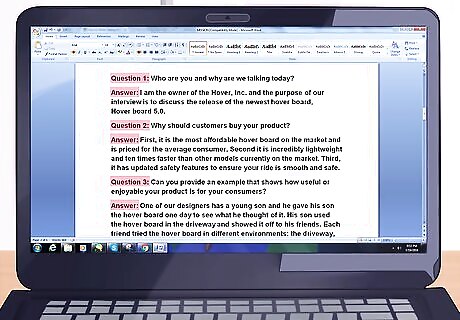
Structure the talking points like a Q&A. Another way you can format your talking points is in the style of a Q&A. This format can be useful if your talking points are going to be used in an interview setting. For example, if you are preparing for an interview about the latest product made by your company, you may lay out your talking points in a series of questions and answers: Question 1: Who are you and why are we talking today? Answer: I am the owner of Hover, Inc. and the purpose of our interview is to discuss the release of the newest hoverboard, Hoverboard 5.0. Question 2: Why should consumers buy your product? Answer: First, it is the most affordable hover board on the market and is priced for the average consumer. Second, it is incredibly lightweight and ten times faster than other models currently on the market. Third, it has updated safety features to ensure your ride is smooth and safe. Question 3: Can you provide an example that shows how useful or enjoyable your product is for consumers? Answer: One of our designers has a young son and he gave his son the hoverboard one day to see what he thought of it. His son used the hoverboard in their driveway and showed it off to his friends. Each friend tried the hoverboard in different environments: the driveway, the park, the sidewalk, and even in a football field. At the end of the day, the designer asked his son what he and his friends thought of the hoverboard. His son told him it was the most fun they had ever had together, and that not a single friend was hurt.

Practice presenting the talking points in front of a colleague or friend. Pretend a colleague or friend is your intended audience and present your talking points to them. Time yourself so you do not go over the allotted time constraint for your talk and use confident body language, maintaining eye contact and a straight, upright pose. Ask your test audience for feedback on your talking points. Ask them if they felt your main message was clear and if your talking points were well supported by examples or arguments. You should also ensure your call to action is clear and your talking points end on a high note, full of energy and engagement.

Revise your talking points before presenting them to your intended audience. Adjust your talking points based on the feedback from your test audience and practice presenting them again. You may want to do this in a mirror so you can look at how you are speaking and how you are carrying your body as you speak. Make sure you use confident, open body language, with eye contact, the use of your hands, and good posture. Run through your talking points several times so you are confident and prepared when you present them to your intended audience.










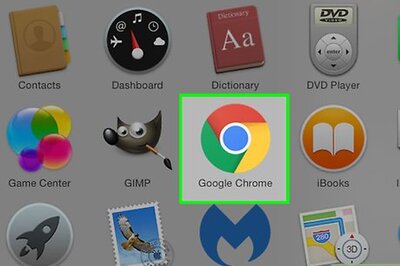








Comments
0 comment